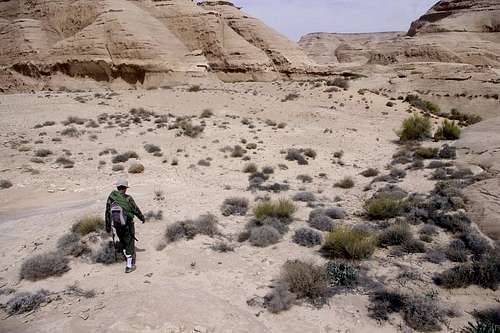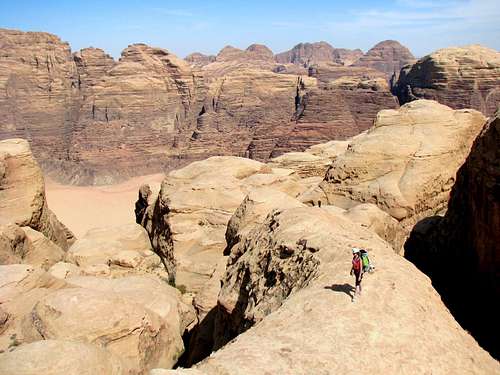Overview
This is the simplified geology of the Wadi Rum.
The Wadi Rum mountains generally consist of 3 rock layers (from bottom to top):
1. Igneous basement (basalt or granite)
2. Purple Um Sahn sandstone
3. White Rum sandstone
These layers are well-defined and tip downwards towards the east. Each ridge has its own characteristic layering. Therefore, when you look at photographs of the Wadi Rum mountains, you can guess where the photo was taken based on the layering that you see.
Diagrammatic representation of the rock stratigraphy of the Wadi Rum, through a west-east line through the mountains:
Basement Igneous Rocks
On the west side of the Wadi Rum mountains you can see the basement of basalt or granite. This includes the Jebel Rum and Jebel Um Ishnrin massifs.
Purple Um Sahn Sandstone
Overlying the basement rocks is a purple Um Sahn sandstone. This is soft and heavily weathered, giving it the appearance of surreal box work and cave formations (like stalagmites and stalactites). Others have described it as "melted wax" formations. It often forms steep walls, often with wave after wave of overhanging ledges. Though the hand holds are plentiful, the rock is a bit friable.
Stacked overhanging ledges (white Rum sandstone can be seen above)

|
Heavily-weathered areas underneath the ledges

|
Massive walls composed of Um Sahn sandstone
![]()
|
Massive walls composed of Um Sahn sandstone
![]()
|
White Rum Sandstone
Generally the summits are composed of a fine-grained white Rum sandstone that forms solid (but slightly gritty) slabs and domes. Compared to the Um Sahn sandstone, there are few holds, but it is a real pleasure to climb.
Slabs and domes of the white Rum sandstone
Shale
There are thin layers of multi-colored shales between layers of the sandstone. These come in a variety of interesting colors such as red, purple, lavender and tan.
The purple shale on the summit of Jebel Khazali contains densely-packed marine fossils.
Multi-colored shales on the summit of Jebel Khazali
![]()
|
Fossils in the summit shale on Jebel Khazali
![]()
|
Multi-colored shales on the summit of Jebel Khazali
![]()
|
Multi-colored shales on the summit of Jebel Khazali
![]()
|
Examples of Stratigraphy
Here are some examples of the geologic stratigraphy on the Wadi Rum mountains, from west to east:
West face of Jebel Un Ishrin massif, above the village of Rum
East face of Jebel Khazali
East face of Jebel Barrah (south summit)
South face of Jebel Arashrasha
Summit Plateaus
The summit plateaus are far from "flat," but can have small parks where the ibex roam. Generally, though, the summits are a maze of domes cut by deep canyons (called "siqs").
A small gravel park on the summit plateau of Jebel Khazali
![]()
|
A maze of domes on the summit plateau of Jebel Rum (Photo: Jek)
![]()
|
Comments
No comments posted yet.

